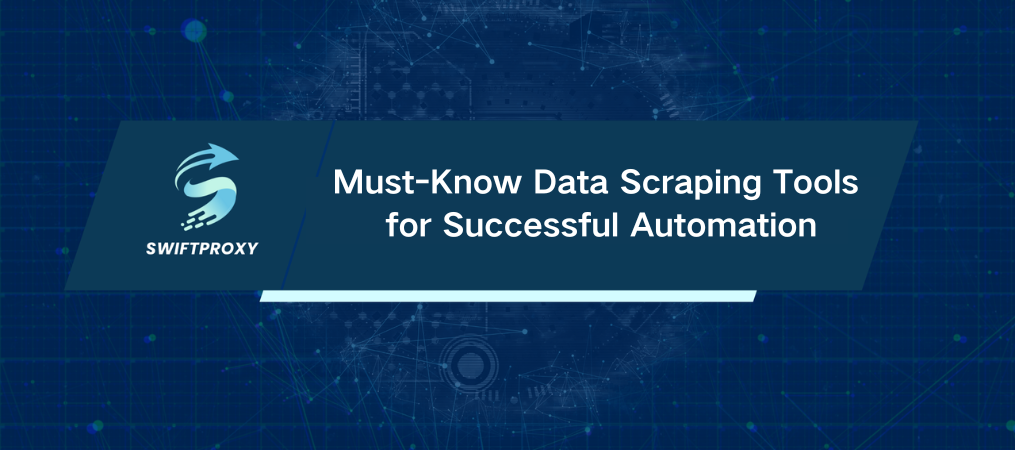Must-Know Data Scraping Tools for Successful Automation

Data scraping is no longer just a buzzword—it's a game-changer. Whether you're gathering insights for market research, competitor analysis, or just automating tedious tasks, knowing how to scrape data efficiently can put you miles ahead. But with so many tools out there, where do you even begin?
In this guide, we'll break down everything from social media scraping tools to proxies that help you scale your scraping efforts without getting blocked. By the end, you'll not only understand the tools you need but also how to pick the right ones for your unique goals.
What's the Deal with Data Scraping
Data scraping is simply the process of extracting large volumes of information from websites, apps, or social media platforms. Whether you're looking to track customer sentiment, gather product details, or collect competitive intelligence, scraping can save you hours, even days, of manual effort. But, the trick is using the right tools to get the job done efficiently—and without triggering security measures that can block your access.
The Data Scraping Tools You Need to Know About
Social Media Scraping Tools
Social media platforms like Facebook, Instagram, Twitter, and LinkedIn are goldmines of valuable data. The trick is pulling it out without running into issues. Social media scraping tools help you extract user profiles, posts, comments, likes, shares, and more. The goal? To get actionable insights without violating platform rules.
If you're researching market trends or doing competitor analysis, social media scraping can give you a comprehensive look at what's being said—and who's saying it. This is especially useful for tracking brand sentiment or analyzing customer feedback at scale.
But be careful. Social media platforms have strict data policies, so using tools that respect those guidelines is key to staying in the clear.
Screen Scraping Tools
Screen scraping tools go a step further—they allow you to pull data directly from the user interface of apps and websites. This is helpful for automating workflows, pulling data from legacy systems, or extracting content from platforms that don’t have an API. It's a more versatile option for businesses that need data in real-time or from sources that aren't easily accessible via traditional APIs.
But here's the catch: while it's powerful, screen scraping can be trickier to implement since it requires the scraping tool to "read" the visual layout of a site. You might run into roadblocks with dynamic content or overly complex site structures. Choose tools that can adapt to these challenges.
Instagram Scraping Tools
Instagram is a powerhouse when it comes to data—if you know how to scrape it. Specific tools designed for Instagram allow you to pull information like user profiles, hashtags, comments, and post data. Whether you're tracking influencer activity or gathering data for market research, these tools can give you a treasure trove of insights.
However, keep in mind that Instagram, like other platforms, has rules to prevent misuse. So, always use a tool that stays compliant with Instagram's data policies, especially if you're scraping at scale.
Proxy Tools
The real secret to successful scraping is proxies. Think of proxies as your shield against getting blocked. Websites and platforms can detect scraping activity by looking for too many requests coming from the same IP address. Proxies allow you to distribute those requests across multiple IPs, which reduces the risk of triggering security measures.
Free proxies can get the job done for smaller scraping jobs, but if you're running large-scale projects, you'll want to invest in premium proxy services that offer more speed, reliability, and anonymity.
Tools for Crawling, Collecting, and Analyzing Data
If you're looking for a full scraping ecosystem, consider tools that also handle crawling and data collection. Data crawlers systematically browse the web and pull relevant content, while data collection tools help organize that content into usable formats. Some advanced scraping tools even allow you to analyze data on the go, so you don't need to export and process it manually.
By incorporating crawlers and collection tools, you can automate entire workflows—from scraping to data analysis—without the hassle.
Choosing the Right Tool for Your Needs
Not all scraping tools are created equal, so the best one for you depends on your specific needs. Here's a quick checklist to help you choose:
Scale of Scraping: If you're scraping large amounts of data or at scale, proxies and premium scraping tools are a must.
Platform Requirements: Consider which platforms you're scraping from. Instagram, Twitter, LinkedIn, and Facebook all have their own rules and limitations.
Type of Data: Do you need structured data (like product details) or unstructured data (like social media posts)? Choose tools that match your data needs.
Compliance: Always ensure your scraping efforts comply with the relevant data privacy laws (think GDPR, CCPA) and platform terms of service.
Conclusion
Data scraping is a powerful tool for gathering and analyzing large amounts of information quickly. With the right tools, you can automate tedious tasks, gain actionable insights, and stay ahead of the competition. The key is choosing the right scraping tool for the job, one that fits your project's scale, complexity, and compliance requirements. Start exploring the options and scrape smarter.

















































